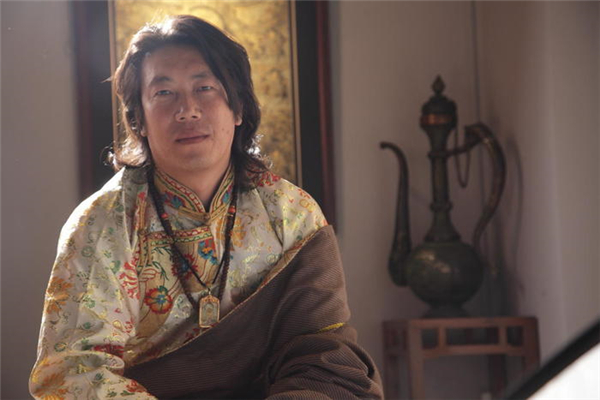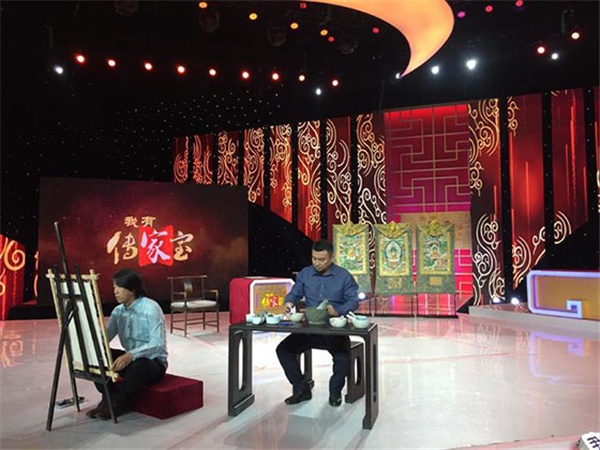Art is the godliness leading to faith
Time 2019-11-12
Renqingcairang is a Tangka prodigy from the security village of Regong, Qinghai Province. As a child, he learned from the Tangka master of Labrang temple, gexi xiezherruhua. With his amazing talent, he quickly became the leading Tangka painter in the industry. His solid painting skills also made him show his unique talent in the black and gold Tangka painting. The five-year original "convex gold technique" has created the precedent of black gold Tangka. In 2015, Renqing let Tangka's works be sold at the Hanhai auction company for 480000 yuan. In 2017, renqingcai, the national culture palace of Beijing, won the nomination award of "great intangible cultural heritage craftsman". The unique works and skills of seizing Tiangong made Renqing, 38, famous at home and abroad.
When the reporter first visited Renqing, he was in the process of creating new works. His skin was swarthy, angular but full of affinity, which was the first impression Renqing left. For such a legendary Thangka craftsman, the reporter did not see the pride of any artists from him, but his modest talk and devotion to Tibetan religious culture left a deep impression.

About artistic style
Reporter: you have been in touch with Thangka art since you were 8 years old. The creation of Thangka in the past 30 years has made you one of the youngest Thangka masters nowadays, and has created a precedent of "convex gold technique". What do you think is special about your Thangka works and other Thangka painters?
Renqingcairang: every place is the same, and every place is different.
Reporter: what about the similarities and differences?
Renqingcairang: Tangka is the integration of Tibetan culture and religion. So far, Tangka has a history of more than 1300 years. In such a long history, Tangka painting has formed a very mature system and style. Every Tangka painter's work must be the inheritance of Tangka history. Therefore, the innovation of Thangka art is not to create a new school of painting. Everyone's works should be the same, and they are the representation of Buddhist art.
Reporter: what's the difference?
Renqingcairang: people who study Tangka art or have some attainments in Tangka creation must have learned Buddhism to some extent. All sentient beings are not the same. There are no two leaves in the world that are exactly the same. So the works of Thangka must be different. Everyone has different understanding and understanding of Buddhism, and there must be some differences in creative techniques. So your work is different. My "embossing technique" is actually to use the artistic effect of relief to reflect a more three-dimensional Thangka style. This method may have a fuller sense of image than the traditional Thangka creation, a more realistic character image, and a more hierarchical sense of color. But this is only a technique, and other artists' Thangka also has its own irreplaceable style.
About honor and the future
Reporter: as far as I know, up to now, you have won numerous honors, including "craftsman of intangible cultural heritage of great powers" and "painter of love Thangka". Works are exhibited in Malta, Australia, India and the United States. It can be said that you have reached the peak of Thangka, so do you have any plans for the future, or do you have any innovation space for your works?
Renqingcairang: actually, I don't like discussing these honors with people. Of course, that's not to say that I ignore these honors. Since I was 8 years old, I have received the training of master gesierri Ruhua. It can be said that his influence on me is a lifetime. What master gescheilruhua taught me was not only the creation techniques of Thangka, but also his wisdom and understanding of Buddhism. He taught me to be religious in Thangka art. What is piety? My understanding now is that every Thangka work I created is not my own, it belongs to the millennium history and culture. Famous Thangka masters like to think of themselves as "craftsmen". Why not be masters? Because we think that we are just the portrayer of Thangka art, which is insignificant compared with the huge Buddhist culture behind Thangka. It's like we recite scriptures, but we can't say that scriptures belong to us. So the honor that Thangka works bring to me is not my own, it should belong to Thangka art. If we indulge in honor, we will lose our faith and spirit. As for the issue of innovation, I think we should follow the fate. Does Buddhism also pursue the fate?
Reporter: it's said that your black gold Thangka needs 30% more work for painters due to the special needs of creation. At the same time, the loss of gold is greatly increased. Do you think it's worth doing so. This kind of high consumption of materials and time will have an impact on the development of your style.
Renqingcairang: as I said just now, I am the practitioner and believer of Thangka art. In fact, I don't think that waves don't waste time, are not worth it, and techniques are not developed. Fate to create, fate to go, he will go. I also believe that every Tangka craftsman has his own way of seeking Buddha. On this way, we are all practitioners.
The 30 minute interview didn't give reporters more opportunities to ask questions. However, Renqing's belief in Tangka makes people believe that it will achieve more in the future. Perhaps, these achievements for him are just a kind of worship and worship for Buddhism and Thangka culture, but his great contribution to the development of Thangka art will be remembered by the world. However, Ren Qing's devotion to Buddhism and art will be further and longer.


